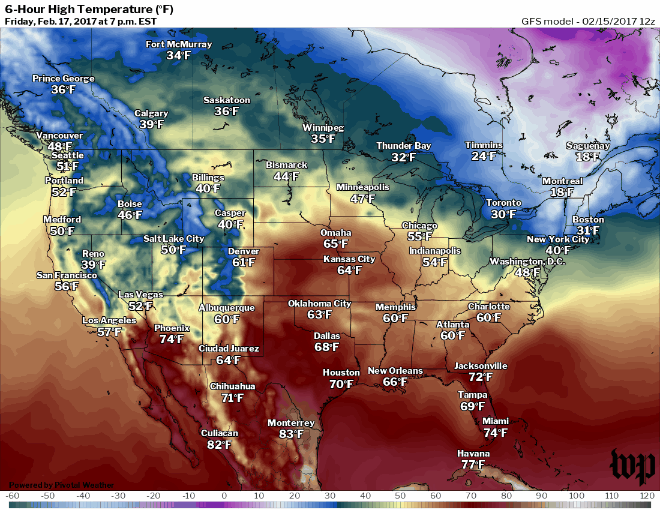‘Fast-forward spring’:
America’s February
warmth is extreme,
and it’s just getting started
You could call the Groundhog’s Feb. 2 declaration of six more weeks of winter fake news or alternative facts. Since Punxsutawney Phil’s pronouncement, spring-like weather has overtaken much of the nation. And some of the month’s warmest weather with respect to normal is yet to come.
So far this month, the temperature has averaged more than five degrees above normal over the Lower 48 — with the warmest temperatures with respect to normal centered over Texas.
“I keep rubbing my eyes and wondering when I am going to wake up from this fast-forward spring,” writes meteorologist Paul Douglas for the Star Tribune. “Weather maps continue to keep looking like March this week with hints of April this weekend. Unreal.”
Through Feb. 13, the nation set an astonishing 1,495 high temperature records compared to just 10 for cold, according to Guy Walton, a meteorologist who tracks such temperature extremes. That’s a “whopping” 150 to 1 ratio of record highs to record lows, Walton said.
Bob Henson, meteorologist and blogger at Weather Underground, compiled a list of some of the more impressive record highs set so far. These three, in particular, are jaw-droppers:
- Magnum, Okla., hit 99 degrees on Feb. 11 — tying the state record for hottest winter temperature ever recorded. Yet it occurred two weeks earlier than the record it matched from Feb. 24, 1918, set in the town of Arapaho.
- Denver hit 80 degrees Feb. 10 — its warmest February temperature on record dating back to 1872.
- Norfolk hit 82 degrees Feb. 12, tying its warmest February temperature on record dating back to 1874.
Henson also reported that the last time Dallas dropped to freezing was Jan. 8. Given the forecast, he said, it might not for the rest of the winter. “That would eclipse the earliest final freeze of the season (Feb. 5, 2000), in records extending back to 1899,” Henson wrote.
In response to the warmth, trees are leafing and flower buds are bursting much earlier than normal. The U.S.A. National Phenology Network tracks spring’s arrival by investigating the timing of leaf-out, flowering and other phenomena. And it is already here over a large portion of the South.
“Spring has arrived three weeks early in New Mexico, Kentucky and Virginia, continuing the pattern we see across the Southeast,” the National Phenology Network website says. “High elevation areas of California and Arizona are also early.”
It’s not just the South where winter has gone missing. Ice formation on the Great Lakes has ground to a halt given the lack of frigid air. Ice covers just 10.3 percent of the lakes compared to an average of 41.7 percent at this time of year.GL Env Research Lab
#GreatLakes #ice cover is currently at 10.3% -- the 1973 - 2016 average is 41.7%. You can now find daily averages at https://www.glerl.noaa.gov/data/ice/#historical …
No measurable snow has fallen in Chicago this month, extending a snow drought that began in mid-December. “The city has not recorded 1″ or more of snow on a calendar day since Dec. 17 some 60 days ago,” WGN-TV reports. With no snow in the forecast over the next week, it is likely to break the record for the longest such snow drought of 66 days set in 1921-1922.
Record warmth for Presidents’ Day weekend
Late this week, warm air will surge into the central and eastern United States. By Sunday, temperatures will be more than 20 degrees above normal from Denver to Washington and northward.
Weather.com says Minneapolis, Chicago, Milwaukee, Cleveland, Memphis and Tulsa could all set record highs between Friday and Sunday.
Even beyond the holiday weekend, milder-than-normal temperatures are predicted to flood the eastern half of the country. The National Weather Service’s 6-to-10– and 8-to-14-day outlooks both express high chances for above-normal temperatures east of the Plains.
The lack of cold can be traced to a vigorous Pacific jet stream, which has bombarded the West Coast with rain and snow but drawn a mild flow of air eastward over the nation while often preventing the entry of Arctic air.
Long-range models hint that some colder air may try to finally barge eastward at the tail end of February or beginning of March. So maybe winter can have one final hurrah. Even so, for many, this will be remembered as a year without a winter — for a second straight year.
59
Comments









